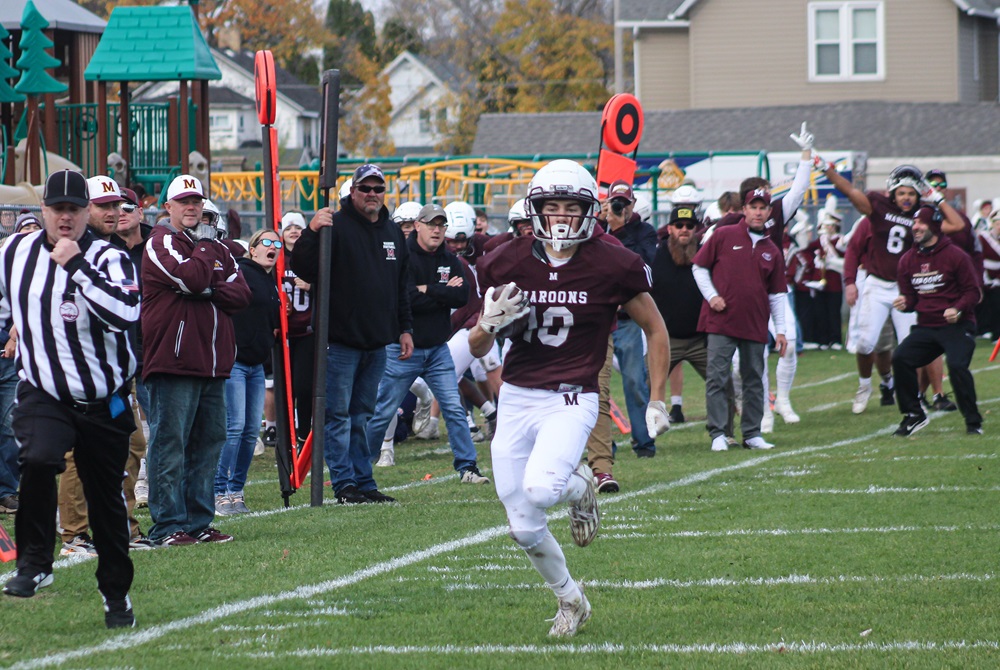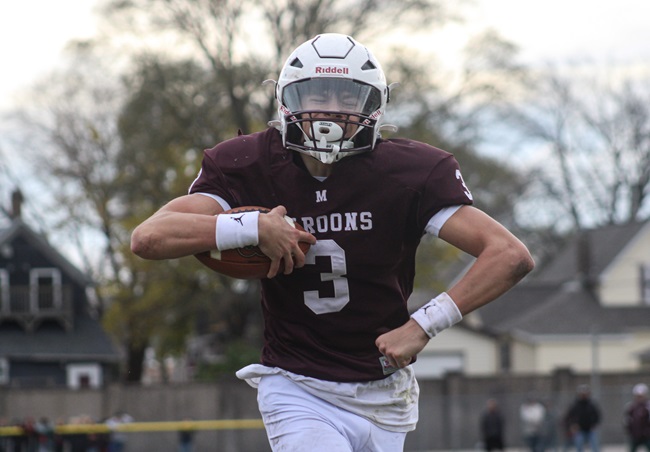
Inside Selection Sunday: Mapnalysis 2012
October 24, 2012
By Geoff Kimmerly
Second Half editor
Between double checking data for more than a third of our 626 football teams, and creating 136 first-round games for our most popular tournament, the morning of MHSAA football "Selection Sunday" is both one of the most exciting and nerve-wracking of the school year.
So for those scratching their heads the last few days over how we picked the brackets this season, I offer one question and one warning:
How would you have done so differently?
And before you answer, remember that moving the position of one school affects at least seven more – if not all 32 in that division.
This was the second year I was involved in the football selection process, which while appearing simple on its face actually is layered with hours of discussions, calculations, checking and re-checking, and anything else we at the MHSAA can do to make sure we’ve created the best tournament possible.
Simply put, it’s more than just drawing circles and calling them good.
Below are a brief description of what we do, the history behind the process, and some challenges we face each time we draw these brackets – including some examples of our toughest this time around.
The process
Our past: The MHSAA playoff structure – with 256 teams in eight divisions, and six wins equaling an automatic berth – debuted in 1999. An 8-player tournament was added in 2011, resulting in nine champions total when November is done.
That’s a long way from our start. The first playoffs were conducted in 1975 with four champions. Four more football classes were added in 1990 for a total of eight champions each fall. Through 1998, only 128 teams made the postseason, based on their playoff point averages within regions (four for each class) that were drawn before the beginning of the season. The drawing of Districts and Regions after the end of the regular season did not begin until the most recent playoff expansion.
In early years of the current process (or until the middle of the last decade), lines were drawn by hand. Dots representing qualifying schools were pasted on maps, one map for each division, and those maps were then covered by plastic sheets. Districts and Regionals literally were drawn with dry-erase markers.
Our present: After a late Saturday night tracking scores, we file in as the sun rises Sunday morning for a final round of gathering results we may still need (which can include making a few early a.m. calls to athletic directors). Then comes re-checking and triple-checking of enrollments, co-ops, some records and more before the numbers are crunched and the field of 256 is set.
Those teams are then split into eight equal divisions based on enrollment, and their locations are marked on digital maps that are projected on wall-size screens and then discussed by nearly half of the MHSAA staff plus a representative from the Michigan High School Football Coaches Association. Only the locations themselves are marked (by yellow dots) – not records, playoff points averages or names of the schools or towns. In fact, mentions of those are strictly prohibited. Records and playoff points are not part of the criteria. Matchups, rivalries, previous playoff pairings, etc. also DO NOT come into play.
Geography rules: Drawing Districts and Regionals is all about location. Travel distance and ease DO come into play. Yes, ease is important. Schools near the same major highway might be further from each other in mileage than other options but have a better trip. A good example this year is in Division 6, which has seven teams in the U.P. and the northern Lower Peninsula. That meant Shelby needed to be included with those teams to make eight, and left Montague to a District that includes Hemlock – more than halfway across the Lower Peninsula. But at least, in this case, much of that trip will be on one roadway, M-46.
There is certainly conversation about every possible option. The staff splits into two groups, each handling four divisions (plus one of the groups handles 8-player too), and then the entire committee comes together to view all nine maps. There wasn’t one division where the group as a whole said, “That looks great, what’s next?”
Observations and answers
A different ballgame: I was asked whatever happened to Districts, meaning teams opening with opponents nearby. Remember that with eight divisions and 32 teams in each, the difference between maximum and minimum enrollments for each division is smaller than it used to be with just four classes, and the probability of finding two schools in the same division next door to each other is lower. This is especially true for our smaller schools, and those pairings are more spread out. Division 7 provides an excellent example. Opponents Dansville and Ottawa Lake Whiteford are 84 miles apart. But in another option considered, Dansville would’ve played Gobles – and those two are separated by 114 miles.
Points still matter: And that means strength of schedule is a big factor. After Districts are drawn, playoff point average determines the home team for those two games and Regionals as well. There are five Districts in which the team with the best or second-best record did not get home games because those teams’ playoff point averages ranked third among the four teams in those brackets. A number of other Districts have 8-1 teams playing at other 8-1 teams. It’s true: there are times a school can’t help the opponents it plays, because of league affiliation perhaps, and they have no control over how an opponent does the rest of the season. But a Class B team playing in a league with Class D schools can’t expect to compare averages well against teams in their division who face similarly-sized opponents during the regular season.
No boating: This didn’t come up last season, but did twice Sunday. We had to decide if it was a better trip for teams in the thumb to go around Saginaw Bay to play northern opponents, or instead send teams a little bit south of the thumb but with a straight shots north. As the bird flies, the thumb teams were closer in some cases. But I’ve never heard of a team hopping into a boat to get to a playoff game.
The fifth wheels: The toughest lines to draw are around areas with five schools in the same division. Remember, Districts come in fours, and one dot affects the rest. The Grand Rapids area gave us tough calls because of five teams in Divisions 2 and 4. The same was true in the southwest corner in Division 7 and the southeast corner in Division 6. No matter how we circled it, one of those teams got stuck with a longer trip. This time, that group included Caledonia, Grand Rapids South Christian, Blissfield and Gobles.
It’s easy to say certain areas of these maps should’ve been drawn differently. But again, keep in mind a statewide view.
Some of our pairings could create gigantic matchups earlier in the playoffs than those teams might like. But again, who is to decide which teams are the best and which matchups most “gigantic” before they prove it on the field? At least three teams touted during this fall as potentially the best in the state this season didn’t even win their conference titles.
And as I said in this analysis last year, determining the playoff schedule is just one step in many. Nine MHSAA champions must survive until the end, regardless of which opponents they face along the way.
Their journeys begin Friday.

Playoff Experience Paying Off as Menominee Pursues Return Trip to Ford Field
By
John Vrancic
Special for MHSAA.com
November 14, 2024
MENOMINEE – Survive and advance.
 The Menominee Maroons did just that Saturday as they escaped with a 35-32 overtime football triumph over the Traverse City St. Francis Gladiators in a Division 7 District Final.
The Menominee Maroons did just that Saturday as they escaped with a 35-32 overtime football triumph over the Traverse City St. Francis Gladiators in a Division 7 District Final.
Menominee sealed the verdict on junior quarterback Tanner Theuerkauf’s seven-yard scoring pass to junior Dawson Bardowski, helping the Maroons (10-1) move a step closer to what they hope will be a return visit to the Finals later this month.
They host North Muskegon (10-1) in Saturday’s Regional Final at noon (CST) – and defeated North Muskegon 32-21 in a Semifinal last season to book their trip to Detroit. Menominee eventually finished last fall as Division 7 runner-up, dropping a 34-30 decision to Jackson Lumen Christi at Ford Field.
But the Maroons have stormed back, thus far improving on their performance from 2023. Their only loss this time has been 13-12 to Division 5 Kingsford in Week 8, and even after St. Francis scored 32 points, Menominee is still giving up only 9.8 per game – and scoring 45.5 per contest, making for an average margin of victory about six points more than this time a year ago.
On Saturday, Menominee trailed 14-0 after St. Francis’ first two possessions but took a 21-17 lead into halftime thanks to a 35-yard interception return by junior defensive back Landen Daigneau with 17 seconds left before the break.
“I’m very proud and excited,” Menominee coach Chad Brandt said after the St. Francis win. “They had a very good football team. Going down by 14 points is not recommended. Our guys missed some assignments, and they got a jump on us.
 “I’m proud of our guys for being resilient. That’s a great football team we beat and I just love the way the guys battled until the final play. The kids will never forget playing in this game, and the fans will not forget being at this game. Their fortitude and will to win were the keys.”
“I’m proud of our guys for being resilient. That’s a great football team we beat and I just love the way the guys battled until the final play. The kids will never forget playing in this game, and the fans will not forget being at this game. Their fortitude and will to win were the keys.”
The Maroons led late before St. Francis forced overtime with a touchdown with 22 seconds left in regulation. The Gladiators then scored first in overtime on a 21-yard field goal, before Bardowski hauled in the game-winner.
“Holding them to three in the overtime was huge,” Theuerkauf said. “That opened things up for us.
“The effort we gave today was unbelievable. That has been our strength all year. We had our backs against the wall, but knew we couldn’t give up. Our defense did a great job. Lot of our guys have been in big games. We knew what we had to do.”
Theuerkauf gained valuable experience last season as the top receiver for older brother Trevor Theuerkauf, now playing at Northern Michigan. Tanner also was a starting defensive back last fall, as was Bardowski.
Senior offensive lineman Lucas Thoune also was part of the starting lineup last season at Ford Field. His Saturday included snagging his first varsity reception – a 13-yarder off a deflection during the second quarter that helped set up a scoring run two plays later.
“That was a heads-up play,” he said. “You just do what’s got to be done. It’s exciting. We’re here for each other.
“I think last year’s run helped us out. I’m willing to be a play-maker for Menominee 10 times out of 10. I’ll never stop being the player I can be. I’m going to do everything I can while I can. I love this team. I love this sport. I don’t know what I’d do without Menominee football.”
The Maroons finished with 318 yards in total offense against the Gladiators. Theuerkauf hit 6-of-14 passes for 76 yards, two touchdowns and an interception. Sophomore Dylan Beal, who filled in after Theuerkauf was shaken up on a play in the third quarter, completed both of his passes for 56. Bardowski caught four for 79 yards and a TD, and junior running back Clayton Miller gained 87 on 16 carries.
 John Vrancic has covered high school sports in the Upper Peninsula since joining the Escanaba Daily Press staff in 1985. He is known most prominently across the peninsula for his extensive coverage of cross country and track & field that frequently appears in newspapers from the Wisconsin border to Lake Huron. He received the James Trethewey Award for Distinguished Service in 2015 from the Upper Peninsula Sportswriters and Sportscasters Association.
John Vrancic has covered high school sports in the Upper Peninsula since joining the Escanaba Daily Press staff in 1985. He is known most prominently across the peninsula for his extensive coverage of cross country and track & field that frequently appears in newspapers from the Wisconsin border to Lake Huron. He received the James Trethewey Award for Distinguished Service in 2015 from the Upper Peninsula Sportswriters and Sportscasters Association.
PHOTOS (Top) Menominee junior Landen Daigneau returns an interception for a touchdown during Saturday’s District championship game against Traverse City St Francis. (Middle) Menominee junior Tanner Theuerkauf celebrates a touchdown against the Gladiators. (Photos by Mitch Vosburg/Escanaba Daily Press.)

